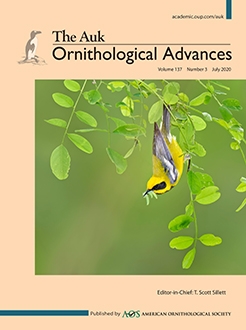Genetic variation and phylogeographic studies have been crucial for understanding mechanisms of speciation. We analyzed genetic variation and phylogeography to reconstruct the demographic history of the Rivoli's Hummingbird (Eugenes fulgens) species complex and also evaluated their morphological differentiation. This widely distributed species inhabits the highlands of Mexico and northern Central America, with 2 subspecies separated by the Isthmus of Tehuantepec (west: E. f. fulgens, east: E. f. viridiceps). We surveyed genetic variation in 2 mitochondrial DNA markers (mtDNA, with 129 individuals) and nuclear DNA (6 microsatellites, with 85 individuals). We also inferred the demographic history, estimated divergence times, and analyzed morphological variation using 470 vouchered specimens. We modeled the current potential distribution of the species using ecological niche modeling and projected it into the past to model the effects of the Pleistocene climatic cycles. Haplotype networks, pairwise FST comparisons, AMOVA, and morphological analysis revealed differences between geographically isolated populations separated by the Isthmus of Tehuantepec (IT; corresponding to the 2 recognized subspecies: fulgens and viridiceps), and by the Motagua-Polochic-Jocotán (MPJ) system fault. Demographic scenarios revealed a contraction in distribution during the last interglacial, and expansion during the Last Glacial Maximum (LGM) with little change since the LGM. Divergence between groups separated by the Isthmus of Tehuantepec ∼59,600 yr ago occurred in the presence of gene flow, suggesting that the Isthmus of Tehuantepec is a semipermeable barrier to gene flow. STRUCTURE analyses of microsatellite data detected 3 genetically differentiated groups. Several results fit a model of recent lineage divergence, including a significant signal of genetic differentiation, demographic expansion, decreased gene flow from past to present, and northward expansion during the LGM and contraction during the interglacial periods. We conclude that the genetic differentiation of E. fulgens in the Madrean Pine-Oak Woodlands resulted from recent geographical isolation of populations separated by natural barriers (IT and MPJ).
LAY SUMMARY
The present work allowed us to reconstruct the phylogeographic pattern and evolutionary history of Eugenes fulgens in the highlands of Mesoamerica.
It revealed the presence of 3 main lineages: populations west of the Isthmus of Tehuantepec (E. fulgens) and 2 populations east of the isthmus (E. viridiceps), geographically isolated from each other by the Isthmus of Tehuantepec and by the Motagua-Polochic-Jocotán system fault.
Our results support the hypothesis that the divergence and demographic expansion within the E. fulgens species complex are associated with the Pleistocene glacial–interglacial cycles.





